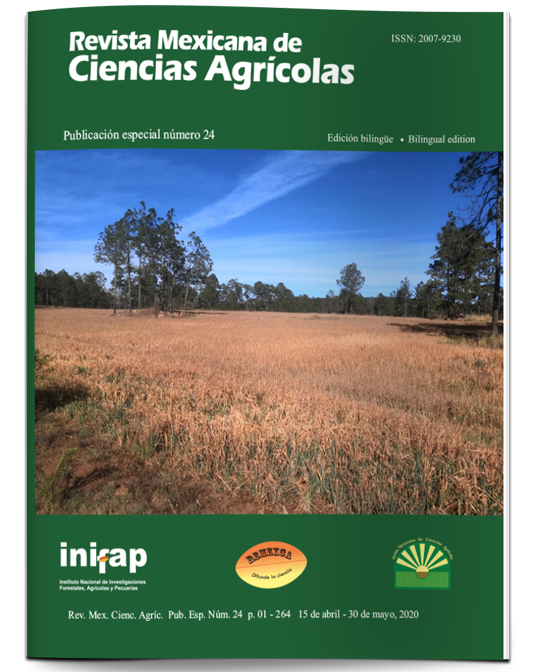Morphological variation in Moringa oleifera Lam. at different population densities
DOI:
https://doi.org/10.29312/remexca.v0i24.2367Keywords:
agronomic management, forage trees, population densitiesAbstract
The tree species are used to improve the nutrition of ruminants and Moringa oleifera, can be a feeding alternative, for forage of high nutritional value. However, topological arrangements modify the structure of the plant and consequently the nutritional value. Therefore, the effect of different population densities (D50, D100 and D200 for 50, 100 and 200 thousand plants ha-1, respectively) and 5 cuts every 28 days on the morphological characteristics of Moringa oleifera was evaluated, under a design of complete random blocks with arrangement in divided plots and three repetitions, in storm conditions and during the period from July to November 2017. The variables evaluated were height regrowth (HR), basal plant diameter (BPD), number of branches (NBP), relative content of chlorophyll (RCC), leaf area index (LAI) and specific leaf area (SLA). The results indicated that there was no interaction (p> 0.05) between population densities and cuts. It was observed that the HR, BPD and NBP values decreased (p> 0.05) with increasing plant density; the opposite case happened with LAI and SLA. The RCC was similar (p> 0.05) in all the evaluated densities. In conclusion, increasing the moringa population density from D50 to D200 negatively affected the aerial morphological components of the plants, mainly the stem, which influenced the number and size of branches.
Downloads
Downloads
Published
How to Cite
Issue
Section
License
The authors who publish in Revista Mexicana de Ciencias Agrícolas accept the following conditions:
In accordance with copyright laws, Revista Mexicana de Ciencias Agrícolas recognizes and respects the authors’ moral right and ownership of property rights which will be transferred to the journal for dissemination in open access. Invariably, all the authors have to sign a letter of transfer of property rights and of originality of the article to Instituto Nacional de Investigaciones Forestales, Agrícolas y Pecuarias (INIFAP) [National Institute of Forestry, Agricultural and Livestock Research]. The author(s) must pay a fee for the reception of articles before proceeding to editorial review.
All the texts published by Revista Mexicana de Ciencias Agrícolas —with no exception— are distributed under a Creative Commons License Attribution-NonCommercial 4.0 International (CC BY-NC 4.0), which allows third parties to use the publication as long as the work’s authorship and its first publication in this journal are mentioned.
The author(s) can enter into independent and additional contractual agreements for the nonexclusive distribution of the version of the article published in Revista Mexicana de Ciencias Agrícolas (for example include it into an institutional repository or publish it in a book) as long as it is clearly and explicitly indicated that the work was published for the first time in Revista Mexicana de Ciencias Agrícolas.
For all the above, the authors shall send the Letter-transfer of Property Rights for the first publication duly filled in and signed by the author(s). This form must be sent as a PDF file to: revista_atm@yahoo.com.mx; cienciasagricola@inifap.gob.mx; remexca2017@gmail.
This work is licensed under a Creative Commons Attribution-Noncommercial 4.0 International license.



